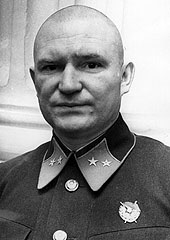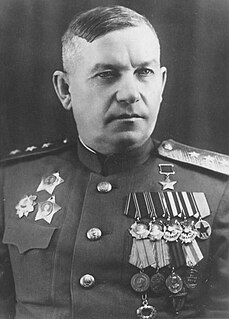
The 3rd Ukrainian Front was a Front of the Red Army during World War II.

The Battle of the Dnieper was a military campaign that took place in 1943 on the Eastern Front of World War II. It was one of the largest operations in World War II, involving almost 4,000,000 troops at a time stretched on a 1,400 kilometres (870 mi) long front. During its four-month duration, the eastern bank of the Dnieper was recovered from German forces by five of the Red Army's fronts, which conducted several assault river crossings to establish several lodgements on the western bank. Subsequently, Kiev was liberated in the Battle of Kiev.

Konstantin Apollonovich Koroteyev was a Soviet Army colonel general and a Hero of the Soviet Union.

The 5th Guards Army was a Soviet Guards formation which fought in many critical actions during World War II under the command of General Aleksey Semenovich Zhadov. The 5th Guards Army was formed in spring 1943 from the 66th Army in recognition of that army's actions during the Battle of Stalingrad. The 5th Guards Army fought in the Battle of Kursk, Belgorod-Khar'kov Offensive Operation, Battle of the Dnieper, Uman–Botoșani Offensive, Lvov–Sandomierz Offensive, Vistula–Oder Offensive, Berlin Offensive, and the Prague Offensive. During the Berlin Offensive elements of the army linked up with American troops at Torgau on the Elbe. Postwar, the army was disbanded as part of the Central Group of Forces.

The 4th Guards Airborne Division was an airborne division of the Red Army that fought as infantry during World War II.
The 79th Guards Rifle Division was an infantry division of the Red Army during World War II.

Vasily Afanasyevich Glazunov was a Soviet lieutenant general, who was the first commander of the Soviet airborne (VDV). He was twice awarded the Hero of the Soviet Union.
The 2nd Guards Airborne Division was a division of the Red Army during World War II.
The 3rd Guards Airborne Division was a Red Army division of World War II. In December 1945 it appears to have become 125th Guards Rifle Division, while serving with 35th Guards Rifle Corps, 27th Army, Carpathian Military District.
The 53rd Army was a field army of the Soviet Union's Red Army which was formed in August 1941, disbanded in December 1941, and reformed in May 1942. It fought throughout World War II before again being disbanded after the war in October 1945. The army was first formed for the Anglo-Soviet invasion of Iran and was disbanded there in December 1941. The army reformed in May 1942. It fought in the Demyansk Pocket, the Battle of Kursk, the Battle of Belgorod, the Battle of the Dnieper, the Battle of the Korsun–Cherkassy Pocket, the Uman–Botoșani Offensive, the Second Jassy–Kishinev Offensive, the Battle of Debrecen, the Budapest Offensive, and the Prague Offensive. At the end of the war in Europe it was moved to the Far East and fought in the Soviet invasion of Manchuria. The army was disbanded in October 1945.
The 32nd Guards Tank Division was a tank formation of the Soviet Army/Soviet Ground Forces. Its predecessor, the 9th Guards Airborne Division, was a Red Army Airborne division of World War II. On 19 June 1945, it became the 116th Guards Rifle Division. In 1946, it became the 14th Guards Mechanized Division. In 1957, it became the 14th Guards Motorized Rifle Division. In 1982, it became the 32nd Guards Tank Division, which was disbanded in June 1989.
The 126th Guards Rifle Division was a Red Army division from 1945 to 1946, part of the Southern Group of Forces. The 126th Guards Rifle Division was originally the 10th Guards Airborne Division, which was transformed into a rifle division on 20 December 1945.

Mikhail Denisenko was a Red Army Major general and Hero of the Soviet Union. He fought in World War II with the Soviet airborne, leading the 36th Guards Rifle Division and 12th Guards Airborne Division. Postwar, Denisenko commanded the 103rd Guards Airborne Division, before his death in 1949 in a parachute accident.

Vasily Vasilyevich Glagolev was a Red Army Colonel general, Hero of the Soviet Union, and commander of the Soviet airborne (VDV). After initially serving in the Imperial Russian Army during World War I, Glagolev joined the Red Army in 1918. He rose to command the 42nd Cavalry Division on the Crimean Front in World War II, going on to command the 73rd and 176th Rifle Divisions as well as the 10th Guards Rifle Corps. Glagolev briefly became the commander of the 9th Army in February 1943 before being transferred to command of the 46th Army, which he would lead until May 1944. He became the 31st Army's commander and led it during the Vitebsk–Orsha Offensive. In January 1945, Glagolev commanded the 9th Guards Army, composed of Soviet airborne divisions converted into infantry. In April 1946, he became the commander of the Soviet airborne forces and died on in 1947 during exercises.
The 37th Guards Rifle Division was an infantry division of the Red Army which fought during World War II.

The 72nd Guards Joint Training Centre is a training centre of the Belarus Armed Forces. It trains warrant officers and junior specialists for the Belarus Armed Forces and is based in Borisov. The centre is currently led by Colonel Igor Korol. The 72nd Guards Joint Training Centre traces its history back to the Soviet 120th Rifle Division. For its actions during the Yelnya Offensive, the division became the 6th Guards Rifle Division in September 1941. In November 1945, the division became the 15th Guards Mechanized Division. On 15 May 1957, it became the 47th Guards Tank Division. The division became a training unit in 1960 and was renamed the 45th Guards Tank Training Division in 1965. In 1987, it became the 72nd Guards District Training Centre. In 1992, it was taken over by Belarus and became the 72nd Guards Joint Training Centre.
The 50th Rifle Division was an infantry division of the Red Army from 1936 to 1946. The division took part in the Soviet invasion of Poland and the Winter War. After Germany launched Operation Barbarossa, the 50th fought in the Battle of Moscow, the Battles of Rzhev, the Donbass Strategic Offensive, the Dnieper–Carpathian Offensive, the First and Second Jassy–Kishinev Offensive, the Vistula–Oder Offensive and the Berlin Offensive.
The 82nd Rifle Corps was a rifle corps of the Red Army and later the Soviet Army.
The 28th Guards Rifle Corps was an elite Guards rifle corps of the Red Army during World War II. It existed from 1943 to 1956.
The 36th Guards Rifle Division was a Guards infantry division of the Red Army during World War II. It was formed from the 9th Airborne Corps in August 1942 as a result of the Soviet need for troops to fight in the Battle of Stalingrad. The division was awarded the honorific Verkhnedneprovsk for its crossing of the Dnieper in September 1943 near that town, later receiving the Order of the Red Banner and the Order of Suvorov, 2nd class, for its actions in the Uman–Botoșani Offensive in March 1944. It fought in the Siege of Budapest during late 1944 and early 1945, receiving the Order of Kutuzov, 2nd class, for its actions. In late 1945, it was converted into the 24th Guards Mechanized Division. Stationed in Romania, it was disbanded in early 1947.








